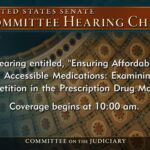NEWS
An Incremental Approach to Social Security Reform
Chairman Baucus remarked at the opening of the first hearing in this series that “[a]ddressing our deficits and debts is an economic issue, a national security issue and a moral issue.” He went on to say that “we have a moral obligation to leave this place better than we found it, but today, our fiscal challenges prevent us from meeting that responsibility.”
Saving on Multi-Source Drugs in Ohio’s Medicaid Program
In my testimony today, I offer evidence that there exists a good opportunity to achieve savings in Ohio’s Medicaid drug program without cutting benefits or quality of care. I will begin my testimony with a brief comment about the Medicaid program in Ohio, then discuss research I have recently published on overspending on certain drugs in Medicaid both nationally and in Ohio, and conclude with a remark regarding possible policy options to consider.
The Stimulus: Two Years Later
The two-year anniversary of the American Recovery and Reinvestment Act (ARRA) presents an appropriate time to evaluate the legislation’s effectiveness. There are many metrics by which one could assess this massive federal policy, but in my testimony today, I will focus on just two: cost and “shovel-readiness.”
Factors Affecting Unemployment Insurance Trust Fund Solvency
This is an important and timely hearing. As Department of Labor (DOL) Assistant Secretary for Employment and Training Jane Oates recently noted in testimony to the Senate Finance Committee, “It is clear that solvency of the UI system will be a concern over the next decade.” I share the concern about the viability and health of many state UI trust funds and am concerned about labor markets in the United States generally over the near and medium term.
Statement Before the Judiciary Committee
To avoid the building of any undue suspense, I will begin with my conclusion. Biologic drugs offer great promise for improving outcomes in healthcare. While they are costly, time consuming and risky products to develop, they offer some of the best hopes for treating some of the nation’s most deadly and debilitating diseases.
Unemployment Insurance
At present, the aggregate growth of the U.S. economy is at a near standstill. Growth in the fourth quarter of 2007 was a paltry 0.6 percent (all GDP growth figures are annualized rate) and indicators for the first quarter of 2008 suggest that growth remained very slow and was possibly negative. An excessive supply of residential housing, inflated home prices, and turmoil in the credit markets are at the center of the current economic weakness. Other sectors and industries could become ensnarled as well. The outlook for the economy for the remainder of 2008 is highly uncertain. Many economists expect an improvement in the second half of the year, though such a timely return back toward trend growth depends on a prompt recovery of credit markets and financial institutions.
Supreme Court Amicus Brief in Davis v. Kentucky Department of Revenue
Amici are scholars of public policy (“the public policy amici”) who wish to ensure that the Court is fully informed of the key economic issues relating to the Kentucky tax exemption challenged in this case, a selective exemption for interest income on municipal bonds issued by Kentucky and its political subdivisions that Kentucky does not grant to interest income on municipal bonds issued by other states. These amici believe that their extensive experience analyzing the economic effects of taxes and other public policies may assist the Court and that they bring a different perspective to the issue than the other parties. The public policy amici are filing this brief solely as individuals and not on behalf of any institution.


















